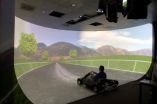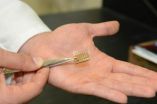(Press-News.org) Scientists have identified a molecular 'flag' in women with breast cancer who do not respond or have become resistant to the hormone drug tamoxifen.
Tamoxifen – used alongside traditional chemotherapy and radiotherapy – blocks the female hormone oestrogen that, in certain breast cancers, is required by the tumour to grow; it has been shown to improve cancer survival rates by up to one third.
However, about one third of patients with the appropriate type of breast cancer – known as oestrogen receptor positive breast cancer – do not respond to tamoxifen or develop resistance to the drug. Oestrogen receptor positive breast cancer is the most common form of the disease accounting for 70% of cases.
Now, a team from the University of Manchester's Paterson Institute for Cancer Research has identified a molecular flag or biomarker that will help doctors predict which patients will respond best to complementary (adjuvant) hormone therapy with tamoxifen.
"The identification of molecular flags to classify subgroups of breast cancer and so determine the best treatment for each patient is of increasing importance in cancer therapy," said study lead Professor Göran Landberg.
"Tamoxifen has been shown to be highly effective in some breast cancer patients when used alongside traditional cancer therapies but, in a third of cases, the result has not been what we would hope. If we can predict which patients will respond to tamoxifen, and those who won't, then this is clearly advantageous as it means the correct treatment is provided instantly which will improve disease outcomes."
The research, funded by the charity Breakthrough Breast Cancer and published in the journal PLoS One, looked at the connective tissue surrounding the tumour, which is known to send signals that help the cancer to grow. The team, part of the Manchester Cancer Research Centre, found that fibroblast cells – the cells that make up connective tissue in our bodies –differ in their characteristics from patient to patient and can give clues about tamoxifen treatment response
Co-author Dr Susann Busch said: "We analysed tissue samples from 564 women with invasive breast cancer, some of whom were given tamoxifen and some who weren't; this allowed us to make a comparison between treatment responses.
"We discovered that women who had low levels of a protein known as pERK in their cancer-associated fibroblasts did not respond to tamoxifen. Testing patients for the pERK flag could help doctors determine whether tamoxifen is an appropriate treatment for their patient or whether alternative therapies should be explored, so saving time and money."
The researchers now plan to further study molecular flags that are characteristic for cancer-associated fibroblasts. Understanding how fibroblasts help the tumour to grow will allow the development of new strategies to block their harmful signals and overcome drug resistance.
###
Notes for editors:
A copy of the paper, entitled 'Low ERK Phosphorylation in Cancer-Associated Fibroblasts Is Associated with Tamoxifen Resistance in Pre-Menopausal Breast Cancer' by Susann Busch et al, published in PLoS One, is available on request.
Reference for survival rate:
Effects of chemotherapy and hormonal therapy for early breast cancer on recurrence and 15-year survival: an overview of the randomised trials, Early Breast Cancer Trialists' Collaborative Group (EBCTCG)* Lancet 2005; 365: 1687
Scientists unravel resistance to breast cancer treatment
2012-10-31
ELSE PRESS RELEASES FROM THIS DATE:
Foggy perception slows us down
2012-10-31
This press release is available in German.
Fog is an atmospheric phenomenon that afflicts millions of drivers every day, impairing visibility and increasing the risk of an accident. The ways people respond to conditions of reduced visibility is a central topic in vision research. It has been shown that people tend to underestimate speeds when visibility is reduced equally at all distances, as for example, when driving with a uniformly fogged windshield. But what happens when the visibility decreases as you look further into the distance, as happens when driving in ...
Social factors trump genetic forces in forging friendships, CU-led study finds
2012-10-31
"Nature teaches beasts to know their friends," wrote Shakespeare. In humans, nature may be less than half of the story, a team led by University of Colorado Boulder researchers has found.
In the first study of its kind, the team found that genetic similarities may help to explain why human birds of a feather flock together, but the full story of why people become friends "is contingent upon the social environment in which individuals interact with one another," the researchers write.
People are more likely to befriend genetically similar people when their environment ...
Team uses antisense technology that exploits gene splicing mechanism to kill cancer cells
2012-10-31
Cold Spring Harbor, N.Y. – Cancer cells grow fast. That's an essential characteristic of what makes them cancer cells. They've crashed through all the cell-cycle checkpoints and are continuously growing and dividing, far outstripping our normal cells. To do this they need to speed up their metabolism.
CSHL Professor Adrian Krainer and his team have found a way to target the cancer cell metabolic process and in the process specifically kill cancer cells.
Nearly 90 years ago the German chemist and Nobel laureate Otto Warburg proposed that cancer's prime cause was a change ...
New tick disease in Switzerland
2012-10-31
Until now, we knew that ticks primarily transmit two pathogens to humans in Switzerland: the bacterium Borrelia burgdorferi – which causes borreliosis – and the early-summer-meningoencephalitis virus, which can cause cerebral inflammation. Now, microbiologists from the University of Zurich confirm the existence of another tick disease in Switzerland – neoehrlichiosis.
The pathogenic bacteria Candidatus Neoehrlichia mikurensis was first discovered in ticks and rodents in Europe and Asia in 1999. In 2010, Head of Molecular Diagnostics at the Institute of Medical Microbiology ...
Seniors particularly vulnerable in Sandy's aftermath
2012-10-31
Older adults left in the wake of Hurricane Sandy will likely suffer disproportionately in the days ahead, based on data from other recent natural disasters.
For example, three quarters of those who perished in Hurricane Katrina were over the age of 60, according to the spring 2006 edition of Public Policy & Aging Report from The Gerontological Society of America (GSA). Similarly, a recent issue of the Journals of Gerontology Series A: Biological Sciences and Medical Sciences reported that the May 2008 earthquake in Wenchuan, China, was associated with a twofold increase ...
Evidence mixed on whether retail clinics disrupt doctor-patient relationships
2012-10-31
A new RAND Corporation study examining the impact of retail medical clinics on the receipt of primary medical care finds mixed evidence about whether the clinics may disrupt doctor-patient relationships.
The study found that people who visit retail medical clinics are less likely to return to a primary care physician for future illnesses and have less continuity of care. However, there was no evidence retail medical clinics disrupted preventive medical care or management of diabetes, two important measures of quality of primary care.
The findings, published online by ...
Stanford scientists build the first all-carbon solar cell
2012-10-31
Stanford University scientists have built the first solar cell made entirely of carbon, a promising alternative to the expensive materials used in photovoltaic devices today.
The results are published in the Oct. 31 online edition of the journal ACS Nano.
"Carbon has the potential to deliver high performance at a low cost," said study senior author Zhenan Bao, a professor of chemical engineering at Stanford. "To the best of our knowledge, this is the first demonstration of a working solar cell that has all of the components made of carbon. This study builds on previous ...
Clinical hypnosis can reduce hot flashes after menopause, Baylor study shows
2012-10-31
Clinical hypnosis can effectively reduce hot flashes and associated symptoms among postmenopausal women, according to a new study conducted by researchers at Baylor University's Mind-Body Medicine Research Laboratory.
Hypnotic relaxation therapy reduced hot flashes by as much as 80 percent, and the findings also showed participants experienced improved quality of life and a lessening of anxiety and depression.
The mind-body therapy study of 187 women over a five-week period measured both physical symptoms of hot flashes and women's self-reporting of flashes. The women ...
Scientists find aphid resistance in black raspberry
2012-10-31
There's good news for fans of black raspberries: A U.S. Department of Agriculture (USDA) scientist and his commercial colleague have found black raspberries that have resistance to a disease-spreading aphid.
Agricultural Research Service (ARS) horticulturist Chad Finn with the agency's Horticultural Crops Research Unit in Corvallis, Ore., and colleague Michael Dossett of Agriculture and Agri-Food Canada are the first to find and report black raspberry resistance to the large raspberry aphid.
ARS is USDA's chief intramural scientific research agency, and this research ...
Green tea found to reduce rate of some GI cancers
2012-10-31
Women who drink green tea may lower their risk of developing some digestive system cancers, especially cancers of the stomach/esophagus and colorectum, according to a study led by researchers from Vanderbilt-Ingram Cancer Center.
The study by lead author Sarah Nechuta, Ph.D., MPH, assistant professor of Medicine, was published online in advance of the Nov. 1 edition of the American Journal of Clinical Nutrition. Wei Zheng, M.D., Ph.D., MPH, professor of Medicine, chief of the Division of Epidemiology and director of the Vanderbilt Epidemiology Center, was the principal ...

